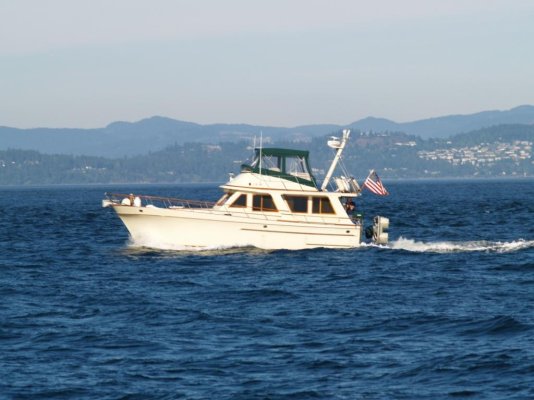Well, we've only had the boat out for a run round the bay since it went back into the water so our observations at this point are based on impressions, not actual data. But I would say in terms of performance there is no discernible difference at all. Boat speed through the water at our cruise rpm settings is basically the same on the knotmeter as it was before the props were reworked. Idle-speed maneuvering is unchanged in terms of how fast the stern can be walked one direction or the other. Idle speed through the marina is exactly the same as it was before.
We observed only two differences as a result of having the props completely reworked and repitched. The boat now tracks much straighter much longer when the wheel is released. Before, the boat would start moving off to port fairly soon after releasing the wheel even though we never had to hold any discernible pressure to hold a course. Where before the king spoke would be at 1:00 when we were holding a course, it is now just a tiny bit to the left of 12:00. Given what the prop shop told us about how horribly the props had been set up before, they were clearly generating a degree of asymmetric thrust.* Or perhaps turbulence that was acting against the rudders although there was no evidence of this at the wheel.* Our boat has mechanical cable/chain steering.
The other difference, but I haven't had time to really study it, is the EGT readings seem to be a tiny bit lower for a given rpm than they were before.
There are some audible differences (improvements) which I assume are due to the complete re-working of the props, the installation of a brand new shaft and cutless bearings on the starboard side, and the installation of a much larger and more positive shaft coupler to match the one that was installed on the port side two years ago.
So I would say we spent a fair amount of money to get things mechanically to where they are supposed to be which should lead to longer lives of the components. But in terms of actual performance change, it's so subtle it's virtually unnoticeable at the power settings we normally cruise at.
The props were not repitched all that much anyway. From 17" and 18" to 16" each. The main thing is we got rid of the mismatched blades, mismatched blade angles, variation in pitch between blades, and a warped hub. And the props are correctly balanced now.
-- Edited by Marin at 01:48, 2008-03-11

